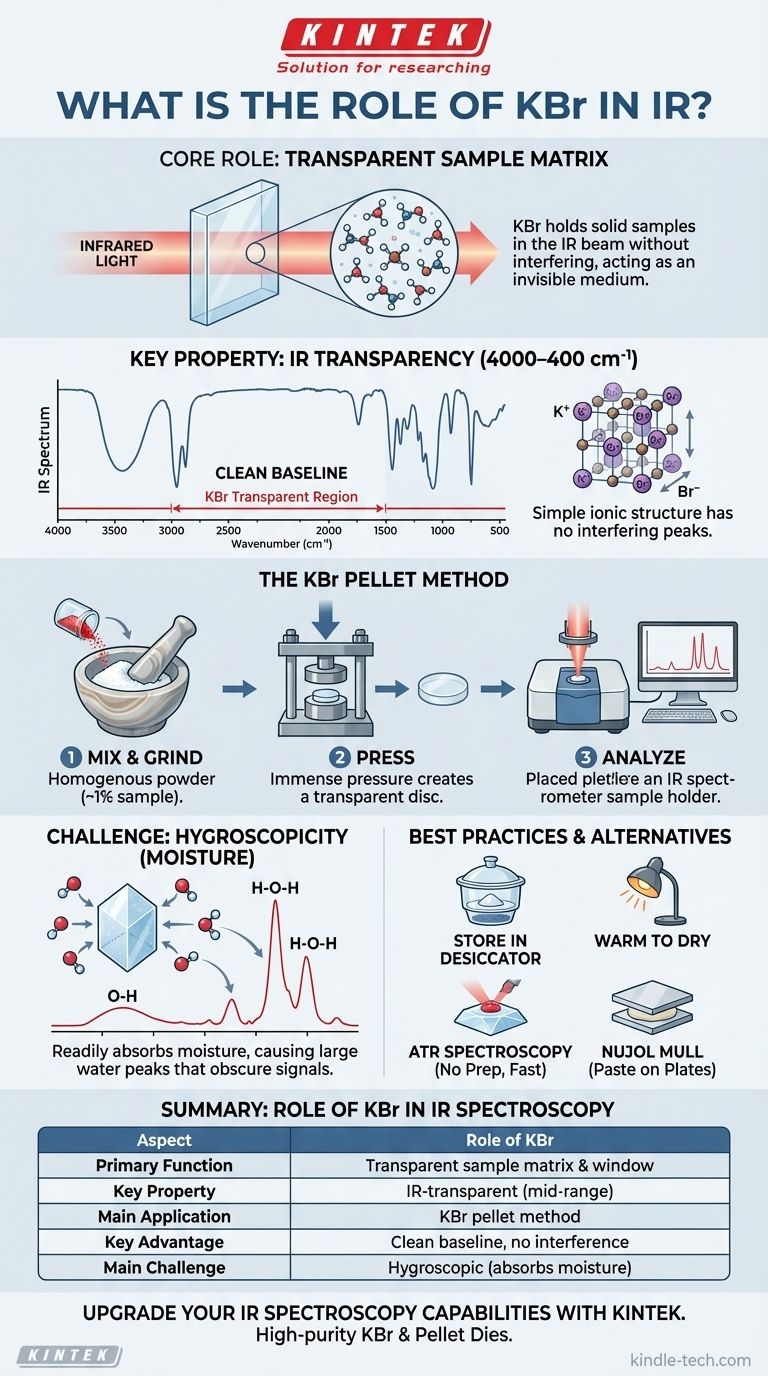赤外分光法(IR)において、臭化カリウム(KBr)は理想的な試料マトリックスおよび窓材として機能します。その主な役割は、測定を妨害することなく、IR光路内に固体試料を保持することです。KBr自体が最も一般的な赤外スペクトルの分析領域で光を吸収しないため、透明な媒体として機能し、試料固有の吸収のみを分光計が測定できるようにします。
IRによる固体試料の分析における中心的な課題は、試料を保持し、かつ赤外光に対して不可視である材料を見つけることです。KBrは、その単純なイオン構造が中赤外領域全体で透明であり、分子振動を観察するための明確な窓を提供するため、業界標準の解決策となっています。
固体試料の標準としてKBrが使用される理由
KBrの使用は、KBrペレット法として知られる一般的な試料調製技術と根本的につながっています。この方法は、ごく少量の固体物質から高品質のスペクトルを得るために設計されています。
IR透明性の原理
KBrの最も重要な特性は、中赤外放射(4000~400 cm⁻¹)に対する透明性です。
化学結合は、その振動周波数が結合の自然な振動周波数と一致するときにIR光を吸収します。KBr結晶格子内のカリウム(K⁺)と臭化物(Br⁻)の間の単純なイオン結合は非常に低い振動周波数を持ち、ほとんどの標準的な機器の400 cm⁻¹のカットオフをはるかに下回ります。
これは、KBrが干渉ピークを生成しないことを意味し、試料の真の吸収ピークを正確に測定できる平坦でクリーンなベースラインをもたらします。
KBrペレット法
この技術には、少量の固体試料(通常、重量の約1%)を高純度のKBr粉末と密接に混合することが含まれます。
まず、試料とKBrをアゲート乳鉢と乳棒を使用して非常に細かい均一な粉末になるまで一緒に粉砕します。この工程により、IR光の散乱を防ぐために試料粒子が十分に小さくなります。
次に、混合物を特殊なダイスに入れ、非常に高い圧力(数トン)下で圧縮します。この圧力により、柔らかいKBr粉末が流れ、薄く、半透明または透明な固体ディスク(ペレットと呼ばれる)に融合します。これにより、試料は固体KBrマトリックス内に閉じ込められ、均一に分散され、分析の準備が整います。

重要なトレードオフの理解
KBrは優れた材料ですが、課題がないわけではありません。高品質のスペクトルを取得するためには、適切な取り扱いが不可欠です。
湿気(吸湿性)の問題
KBrの最も重大な欠点は、それが吸湿性であり、空気中の湿気を容易に吸収することです。
水(H₂O)は非常に強いIR吸収帯を持っています。約3400 cm⁻¹付近のO-H伸縮振動のブロードなピークと、約1640 cm⁻¹付近のH-O-H変角振動の鋭いピークです。KBrが「濡れている」場合、これらの大きな水ピークが、それらの領域で試料からの重要なシグナルを覆い隠す可能性があります。
KBr取り扱いのベストプラクティス
湿気による汚染を避けるため、分光グレードのKBrは使用しないときはデシケーターまたは乾燥オーブンに保管する必要があります。
ペレットを調製する際は、手早く作業するのが最善です。一部の研究所では、吸着した水分を飛ばすために、使用直前にKBr粉末をヒートランプの下で軽く加熱します。
KBrペレットの代替法
KBrペレットに関連する課題により、他の方法が開発されてきました。
ヌジョールマル法は、固体試料を少量の鉱油(ヌジョール)と混合してペーストを作成し、それを2枚の塩板(通常はKBrまたはNaCl製)の間に塗り広げる方法です。これはより高速ですが、スペクトルにヌジョール自体のC-H吸収ピークが現れるという複雑さが加わります。
全反射減衰(ATR)は、サンプル調製がほとんど不要な、現代的で人気のある代替手段です。固体試料を(ダイヤモンドやZnSeなどの)結晶に押し付けるだけで、IR光線が表面と相互作用します。ATRは高速で簡単であり、KBrに関連するすべての湿気の問題を回避できます。
目標に応じた適切な選択
最適な試料調製技術は、試料、装置、および分析ニーズによって異なります。
- 可能な限り最高のスペクトル分解能を安定した固体で得ることに主眼を置く場合: 湿気を完全に排除するように注意深く実施されたKBrペレット法は、透過分光法において依然としてゴールドスタンダードです。
- サンプル調製を最小限に抑えた迅速なルーチン分析に主眼を置く場合: 全反射減衰(ATR)は、現代の研究所ではほとんどの場合、より優れていて便利な選択肢です。
- 試料が高圧に敏感であるか、イオン性のKBrマトリックスと反応する可能性がある場合: ヌジョールマル法またはATRの方が安全でより適切な方法です。
マトリックス材料の特性と限界を理解することは、クリーンで信頼性が高く、解釈可能なIRスペクトルを取得するための第一歩です。
要約表:
| 側面 | IR分光法におけるKBrの役割 |
|---|---|
| 主な機能 | 透明な試料マトリックスおよび窓材として機能する |
| 主要な特性 | 中赤外領域(4000~400 cm⁻¹)でIR透明 |
| 主な用途 | 固体試料分析のためのKBrペレット法 |
| 主な利点 | 干渉ピークがなくクリーンなベースラインを提供する |
| 主な課題 | 吸湿性 - 湿気を避けるために慎重な取り扱いが必要 |
| 一般的な代替法 | ATR分光法、ヌジョールマル法 |
KINTEKでIR分光能力をアップグレード
IR分析の試料調製に苦労していませんか?KINTEKは、分光グレードの臭化カリウム(KBr)や、信頼性の高いハイスペクトル分解能結果のために設計されたペレットダイを含む、高純度実験用機器および消耗品の専門サプライヤーです。
当社の製品は以下を支援します。
- 水分管理されたKBrによる優れたスペクトル明瞭度の達成
- 固体試料分析ワークフローの合理化
- 一貫した実験室性能の維持
従来の透過分光法に取り組んでいる場合でも、最新のATR技術に取り組んでいる場合でも、お客様の研究所の特定のニーズを満たすソリューションをご用意しています。
IR分光結果の向上にご興味がありますか? 今すぐ専門家にお問い合わせいただき、お客様のアプリケーション要件についてご相談の上、KINTEKがお客様の研究および品質管理プロセスをどのようにサポートできるかをご確認ください。
ビジュアルガイド

関連製品
- サンプル前処理用実験室用乳鉢グラインダー
- ラボ用油圧ペレットプレス機
- ボタン電池用実験室用油圧プレス ラボペレットプレス
- 実験材料・分析用金属顕微鏡試料作製機
- 効率的なサンプル混合と均質化のための実験用ディスク回転ミキサー










